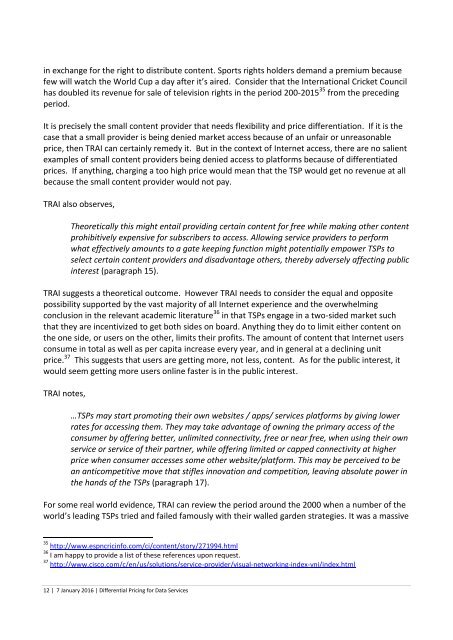Layton
Layton
Layton
You also want an ePaper? Increase the reach of your titles
YUMPU automatically turns print PDFs into web optimized ePapers that Google loves.
in exchange for the right to distribute content. Sports rights holders demand a premium because<br />
few will watch the World Cup a day after it’s aired. Consider that the International Cricket Council<br />
has doubled its revenue for sale of television rights in the period 200-2015 35 from the preceding<br />
period.<br />
It is precisely the small content provider that needs flexibility and price differentiation. If it is the<br />
case that a small provider is being denied market access because of an unfair or unreasonable<br />
price, then TRAI can certainly remedy it. But in the context of Internet access, there are no salient<br />
examples of small content providers being denied access to platforms because of differentiated<br />
prices. If anything, charging a too high price would mean that the TSP would get no revenue at all<br />
because the small content provider would not pay.<br />
TRAI also observes,<br />
Theoretically this might entail providing certain content for free while making other content<br />
prohibitively expensive for subscribers to access. Allowing service providers to perform<br />
what effectively amounts to a gate keeping function might potentially empower TSPs to<br />
select certain content providers and disadvantage others, thereby adversely affecting public<br />
interest (paragraph 15).<br />
TRAI suggests a theoretical outcome. However TRAI needs to consider the equal and opposite<br />
possibility supported by the vast majority of all Internet experience and the overwhelming<br />
conclusion in the relevant academic literature 36 in that TSPs engage in a two-sided market such<br />
that they are incentivized to get both sides on board. Anything they do to limit either content on<br />
the one side, or users on the other, limits their profits. The amount of content that Internet users<br />
consume in total as well as per capita increase every year, and in general at a declining unit<br />
price. 37 This suggests that users are getting more, not less, content. As for the public interest, it<br />
would seem getting more users online faster is in the public interest.<br />
TRAI notes,<br />
…TSPs may start promoting their own websites / apps/ services platforms by giving lower<br />
rates for accessing them. They may take advantage of owning the primary access of the<br />
consumer by offering better, unlimited connectivity, free or near free, when using their own<br />
service or service of their partner, while offering limited or capped connectivity at higher<br />
price when consumer accesses some other website/platform. This may be perceived to be<br />
an anticompetitive move that stifles innovation and competition, leaving absolute power in<br />
the hands of the TSPs (paragraph 17).<br />
For some real world evidence, TRAI can review the period around the 2000 when a number of the<br />
world’s leading TSPs tried and failed famously with their walled garden strategies. It was a massive<br />
35 http://www.espncricinfo.com/ci/content/story/271994.html<br />
36 I am happy to provide a list of these references upon request.<br />
37 http://www.cisco.com/c/en/us/solutions/service-provider/visual-networking-index-vni/index.html<br />
12 | 7 January 2016 | Differential Pricing for Data Services


